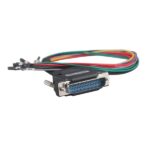The fight against health care fraud in the United States is a long-standing and critical endeavor, aimed at protecting both consumers and taxpayer dollars. At the heart of this battle is the Health Care Fraud and Abuse Control (HCFAC) Program. Understanding its origins is key to appreciating its significance and ongoing impact. So, Who Created The Health Care Fraud And Abuse Control Program, and why is it so crucial?
The Health Care Fraud and Abuse Control Program was not created by a single individual, but rather through bipartisan legislative effort. It was established as part of the Health Insurance Portability and Accountability Act of 1996 (HIPAA). HIPAA, while primarily known for its privacy regulations, also included significant measures to combat health care fraud and abuse. This landmark legislation, signed into law by President Bill Clinton, reflected a growing concern and commitment to safeguard the integrity of the nation’s healthcare system.
The architects of HIPAA and, consequently, the HCFAC program, were numerous members of Congress from both Republican and Democratic parties who recognized the escalating problem of healthcare fraud. They understood the need for a dedicated program to coordinate federal, state, and local law enforcement efforts to combat fraud, waste, and abuse within health insurance and health care delivery. The intention was to move beyond simply reacting to fraud and instead proactively prevent it.
Several key agencies are integral to the HCFAC Program’s operation. These include:
- The Department of Health and Human Services (HHS): Specifically, the Office of Inspector General (OIG) within HHS plays a leading role. HHS OIG is responsible for overseeing Medicare and Medicaid and for detecting and preventing fraud and abuse in HHS programs. They conduct audits, evaluations, and investigations to ensure program integrity.
- The Department of Justice (DOJ): The DOJ is the primary law enforcement agency responsible for prosecuting health care fraud offenses. They work closely with HHS OIG and other agencies to bring criminal and civil actions against individuals and entities engaged in fraudulent activities.
- The Centers for Medicare & Medicaid Services (CMS): CMS is responsible for administering the Medicare and Medicaid programs. They work to implement fraud prevention strategies, such as enhanced provider screening and the use of advanced fraud detection technology.
Since its inception in 1997, the HCFAC Program has been at the forefront of combating health care fraud, waste, and abuse. The program has continually adapted to evolving fraud schemes, moving towards a proactive “fraud prevention” approach rather than a reactive “pay and chase” model. This shift has been significantly enhanced by tools and initiatives like the Healthcare Fraud Prevention Partnership, which fosters collaboration between government and the private sector.
The success of the HCFAC Program is evident in its financial recoveries. In Fiscal Year 2016 alone, the government recovered over $3.3 billion from health care fraud judgments and settlements. Cumulatively, the program has returned more than $31 billion to the Medicare Trust Funds since its beginning. Notably, in FY 2016, for every dollar invested in the HCFAC program, $5.00 was returned.
Key initiatives operating under the HCFAC umbrella include:
- Health Care Fraud Prevention and Enforcement Action Team (HEAT): A joint effort by HHS OIG and DOJ, HEAT is crucial in coordinating and strengthening efforts to combat health care fraud.
- Medicare Fraud Strike Force: A core component of HEAT, this interagency task force targets emerging and migrating fraud schemes, including those perpetrated by criminals posing as health care providers. Since 2007, the Strike Force has charged over 3,018 individuals involved in more than $10.8 billion in fraud.
- The False Claims Act: This powerful legal tool is used to recover funds in civil cases involving fraud against federal health care programs. In 2016, over $2.5 billion was recovered through False Claims Act settlements and judgments.
Furthermore, the HCFAC program supports the development and implementation of state-of-the-art fraud detection technologies. HHS OIG utilizes data analysis, predictive analytics, and trend evaluation to proactively identify and target potential fraud. Similarly, CMS employs the Fraud Prevention System (FPS), which analyzes Medicare claims in real-time to detect suspicious billing patterns before payments are made.
Enhanced provider screening and enrollment requirements are another critical aspect of fraud prevention. CMS has implemented stricter measures to ensure that only eligible and legitimate providers can enroll in Medicare, leading to the deactivation and revocation of hundreds of thousands of enrollment records of ineligible providers.
The Health Care Fraud Prevention Partnership (HFPP) exemplifies the collaborative spirit of the HCFAC program. This partnership brings together private insurers, states, and associations to share data and best practices to prevent fraud on a national scale. With over 70 partner organizations, HFPP’s impact continues to grow, leading to proactive measures to stop fraudulent payments.
In conclusion, the Health Care Fraud and Abuse Control Program was created through the HIPAA legislation of 1996, representing a bipartisan commitment to combatting health care fraud. While no single person can be credited, it was the collective effort of numerous legislators and government agencies like HHS, OIG, DOJ, and CMS that brought this vital program to life. The HCFAC Program remains a cornerstone of efforts to protect consumers and taxpayers by aggressively fighting fraud, waste, and abuse in the U.S. healthcare system, ensuring that public funds are used for their intended purpose: providing quality health care to beneficiaries.
